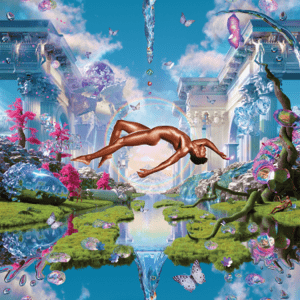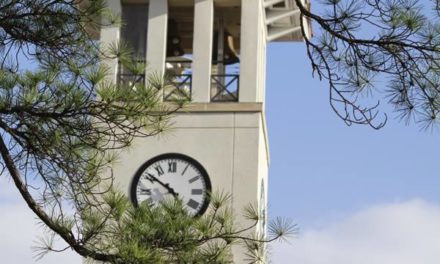“I’m backstage, and this is, like, not a part of the show, but I’m taking a mean s- – -. . . but I’m gonna be, like, a minute or two and I’ll be right back,” echoed the disembodied voice of Lil Nas X. Thousands of people, packed into the general admission section of Coca-Cola Roxy, erupted into laughter.
It was Sept. 28, the rapper’s second night at the venue and the eighth stop on his debut “Montero Tour.” This mid-show bathroom break only increased the eager anticipation rippling through the crowd. I grinned, soaking up the mirth palpable among surrounding strangers. None of us were too surprised by this irreverent interruption. Such shocking, self-aware humor is characteristic of the eccentric Lil Nas X.
X has quickly become one of this generation’s most widely-known artists. After coming out as gay on Twitter in 2019, he has increasingly embraced controversy. As the first openly queer Black artist to win an award from the Country Music Association, he has taken full advantage of his ever-evolving public image. X’s strong online presence and enthusiastic following contribute to an atmosphere of unapologetic existence when it comes to his music.
At Wednesday’s concert, this wild self-expression took flight. His fans were decked out in everything from cowboy hats to platform heels, armed with elaborate makeup and defiant of gender norms. A couple of scraps of butterfly-shaped confetti hovered by the ceiling. Far larger butterflies adorned an elaborate gold frame surrounding the stage. When the singer finally appeared, a euphoric uproar arose as his larger-than-life shadow splashed across the stage’s velvet curtain. I cheered along, knowing that I wasn’t the only eccentric concertgoer who had been looking forward to this moment for months.
Separated into three acts, which were projected onto the curtain in an ornate script as “Rebirth,” “Transformation” and “Becoming,” the show unfolded as part dystopian epic, part campy fairy tale. The stage’s backdrop shifted from colorful galaxies to ornate palaces to shattered temples, the motif of glittery butterflies constantly fluttering throughout. Videos played at the beginning of each act in which a character referred to in the concert program as “The Wizard of Naz” told the story of “one of those special [humans]. . . how one day, he found himself through music, and his music found us. . . .”
This special human, Lil Nas X himself, sprang onto the stage with boundless energy, surrounded by backup dancers that accentuated each lyric with fierce choreography. The costume changes were frequent and reflected the various color schemes of the stage’s lighting and backdrop. The audience sang along with every song, especially hits like “Old Town Road” and “INDUSTRY BABY.” X beamed, clearly thrilled to be performing. Onstage, he made himself a legend.
There was a certain kind of intimacy between the crowd and the music. Lil Nas X had written these songs about his sexuality and courage in the face of discrimination. This resilience was something that X had already displayed on tour, flipping off his haters with glee. When homophobic protestors showed up outside his Boston concert on Sept. 18, he had his team send them pizza. This tendency to mock backlash and react publicly on social media endears X’s fans to him. At Coca-Cola Roxy, every attendee seemed to find something in his performance to relate to or a particular lyric to scream as loudly as possible. There was a feeling of common reliance on the fabulous energy pouring from the stage.
In a pre-recorded video played just before the “Wizard of Naz” introduced Act Three, X acted out a homophobic church sermon he had experienced as a child. The placement of this emotional, surreal scene just before a passionate performance of “MONTERO (Call Me By Your Name)” emphasized how valuable queer pride is to his music. The energy of “MONTERO” differed little from the fast-paced freedom of the night’s previous songs, emphasizing that despite homophobia, Hill found strength in authenticity. As he sang the final chorus, he donned blue butterfly wings, symbolizing his transformation into a creature of unique power.
Although the hour-long concert felt rather short, that reduced length contributed to the value of the story that the “Wizard of Naz” was telling. X’s songs sped along meticulously without pause (besides his impromptu trip to the bathroom). This rapid pace allowed the resplendent origin story of the trailblazing artist to be told as dramatically as if in a film. X was unafraid to shine, confident in the unconditional validation of his fans. That validation was most potent when he made out with a backup dancer and the theater filled with cheering.
As a queer member of Gen Z, I appreciated the show’s authenticity. X is flamboyant but also self-aware, and his ability to make fun of himself means that he is relatable. I was one of many in that crowd who were invigorated by his unapologetically triumphant performance. He turned the often lonely topic of sexuality into a colorful celebration of the self. With his explosive talent and flair for the dramatic, X is paving the way for a new kind of authentic musicality that will emerge from the margins in years to come.
Brigid May is from Holly Springs, North Carolina, double majoring in harp performance and classics/English. Outside of the Wheel, they perform with the Emory University Symphony Orchestra and serve on the Emory Musician's Network executive board. They are a lover of poetry, handmade jewelry, and tarot readings.





